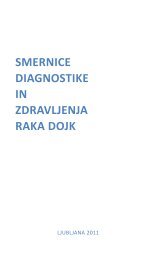Create successful ePaper yourself
Turn your PDF publications into a flip-book with our unique Google optimized e-Paper software.
Stem cells in toxicology<br />
Laura Gribaldo<br />
ECVAM-IHCP-JRC, European Commission<br />
Rapidly increasing knowledge <strong>of</strong> human stem cells <strong>of</strong>fers the unique possibility to establish<br />
in vitro toxicological methods in many different areas in which currently only primary cell<br />
cultures, cell lines derived from animals or immortalized cells are used. Stem cells <strong>of</strong> different<br />
sources can be used as “cell factory” for human cell based systems. However, the relevance<br />
and reliability <strong>of</strong> such in vitro test systems is strongly correlated to the quality <strong>of</strong> the source,<br />
i.e. the stem cells used, standardized differentiation protocols, the purification rate <strong>of</strong> stem<br />
cells and their derivates, selected toxicological endpoints as well as the developed prediction<br />
models. Hematopoiesis is a fascinating system in which pluripotent hematopoietic stem<br />
cells (PHSCs) differentiate into many highly specialised circulating blood cells. At least<br />
95% <strong>of</strong> hematopoietic cells fall into morphologically recognizable cell lineages. Dormant<br />
PHSCs are recruited into the cell cycle by many cytokines as IL-1, IL-3, IL-4, IL-6, IL-11,<br />
IL-12, SCF (stem cell factor), G-CSF (granulocyte-colony stimulating factor), M-CSF<br />
(macrophage-colony stimulating factor), Epo (erythropoietin), LIF (leukemia inhibitory<br />
factor), FLk2/FLT3 (tyrosine kinase receptor) ligand, TPO (thrombopoietin).<br />
Lineage-specific factors support the survival, proliferation and maturation <strong>of</strong> progenitors<br />
that are committed through hypothetical stochastic expression <strong>of</strong> specific groups <strong>of</strong><br />
differentiation genes. The foetal stem cells, for their plasticity, can generate a perpetual<br />
supply <strong>of</strong> healthy, normal human cells for disease modeling, drug discovery, and toxicology,<br />
because they can potentially generate suitable models for cardiotoxicity, hepatotoxicity,<br />
genotoxicity/epigenetic and reproductive toxicology. Furthermore, gender-differences in<br />
drug sensitivity can be evaluated using human hematopoietic stem cells from different<br />
donors.<br />
26<br />
l11
















